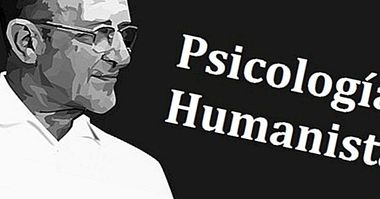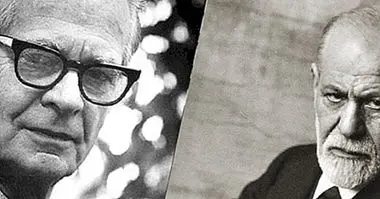What is "the Self" in Psychology?
In psychology concepts like "I", "Ego" or "Self" are often used to designate the self-referential dimension of human experience . The perception of continuity and coherence, and therefore the development of the sense of identity, depends on our conceiving a part of ourselves as the subject that leads our lives.
Since the end of the 19th century William James (1842-1910) distinguished between the "I" as an observer and the "Me" as the object of experience, a large number of theories that try to define what is the I . Next we will describe the most relevant ones through a brief historical tour.
- Maybe you are interested: "History of Psychology: authors and main theories"
The ego in psychoanalysis
In the theory of Sigmund Freud (1856-1939) the I is understood as the conscious part of the mind , which must satisfy the instinctive and unconscious impulses of the It taking into account the demands of the external world and of one's own consciousness - the superego, constituted by internalized social norms.
The self or identity would therefore be an intermediate instance between the biology of an individual and the world around him. According to Freud, his functions include perception, information management, reasoning and control of defense mechanisms.
His disciple Carl Gustav Jung (1875-1961) defined the I as the nucleus of consciousness ; every psychic phenomenon or vital experience that is detected by the Self becomes conscious. Thus, the sense of the I is understood as a complex structure with a double component: somatic and psychic.
In addition to Jung the I, center of the identity, is immersed in the Self ("Self"), which constitutes the core of the personality in general; The Self includes the unconscious, as well as the conscious part of the experience. However, we are unable to experience the Self completely because we are anchored to the Self and consciousness.
- Related article: "The id, the self and the superego, according to Sigmund Freud"
The social roles of the self
In the social sciences of the first half of the twentieth century symbolic interactionism enjoyed a remarkable popularity, a theoretical current that stated that people interpret the world and its elements from the meanings given to them socially. The Self is built from face-to-face interaction and of the social structure.
If we speak of the I and the identity, within the symbolic interactionism it is worth highlighting the dramaturgical model of Erving Goffman (1922-1982). This author believed that people, as if we were actors, try to appear consistent with others by adopting roles. For Goffman the Yo it is nothing more than the set of roles that we represent .
Later the social psychologist Mark Snyder (1947-) developed his theory of self-observation or self-monitoring. This model affirms that people high in self-observation adapt their roles, and therefore their identity, to the situation in which they find themselves; on the contrary, those who self-monitor little show more the "I" with which they identify themselves.
- Maybe you're interested: "The dramaturgical model of Erving Goffman"
Multiplicity and complexity of identity
Among recent developments in the conception of the self from social psychology, two particular theories stand out: Patricia Linville's model of self-complexity and the theory of self-disagreement by E. Tory Higgins. The central aspect of both models is that the Self is understood as the mental representations that we make of ourselves .
The model of self-complexity proposes that identity depends on our social roles, interpersonal relationships, nuclear personality traits and the activities we perform, such as professional career. The concept of "autocomplexity" refers to the number of representations that make up the ego, as well as its degree of differentiation.
According to Linville, people with high self-complexity are more resistant to negative life events , since even if a part of their identity is questioned or weakened by the experiences there will always be other parts of the Self that they can use as a psychological anchor.
The Higgins Self-Discrepancy Theory
In his theory of self-disagreement, Higgins also states that the Self is not a unitary concept, although it defines the different components of identity based on two parameters: the domains of the Self and the views of the Self . In this last criterion we find the perspective of the person about herself, as well as the one she believes that significant persons have.
In the domains of the self, which can be associated with one's own perspective or that of others, we find the real I (how I am), the ideal I (how I would like to be), the I that should be, the potential I (how could I reach be) and the future I, which is the identity we hope to be.
Higgins believes that the real I, both from the point of view of oneself and from which we suppose that significant persons have, is the basis of our self-concept. On the other hand, the rest of aspects are the guides of the self, which they serve as model and reference for us to act and to evaluate our behavior.
Post-rationalist cognitive theories
Vittorio Guidano (1944-1999) is considered the main pioneer of post-rationalist psychology. This theoretical orientation arises as a reaction to the predominance of positivist and rationalist philosophies, which affirm that there is an objective reality that can be perceived and understood in an accurate way through the senses and logic.
From the cognitive-constructivist psychological theories, the fundamental relevance of language is defended in the way in which we interpret the world that surrounds us and we share these perspectives. Through language we organize our experiences in the form of narrations , from which emerge the memory and identity.
Thus, the I is not conceived as a defined entity, but as the constant process of construction of a coherent autobiographical narrative that allows us to give meaning to our experiences. From the post-nationalist perspective, the problem of identity becomes a linguistic-narrative issue.
Guidano also distinguished between the Self and Me. While defined the Self as the body-emotional dimension of experience, predominantly unconscious, for this author the Self is the part of the Self that observes and generates meanings through language. The union of the I and the Me results from the creation of coherent narratives that claim to be explanatory.



















